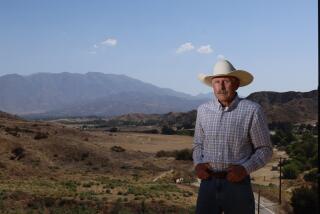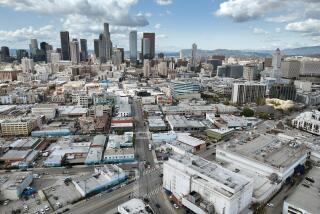El Segundo has a clear vision for Smoky Hollow’s future
Smoky Hollow.
Is that a good or a bad name for a neighborhood meant to attract people in creative fields such as entertainment, technology and advertising?
That’s one of many questions El Segundo leaders have pondered in their campaign to turn the aging Smoky Hollow industrial district into a fashionable enclave of offbeat office buildings and workshops.
The attraction? Former warehouses and manufacturing buildings are in demand on the Westside and can command higher rents than traditional high-rises.
Smoky Hollow got its name because smoke once settled there from Standard Oil Co.’s refinery, which opened in 1911 and now is operated by Chevron Corp. The area is no longer smoky, and local officials once contemplated calling it simply “The Hollow” to prevent people from getting the wrong impression.
The neighborhood was home for decades to manufacturers and vendors serving neighboring aerospace firms, but the defense industry shrank after the end of the Cold War. By the mid-2000s, Smoky Hollow was beginning to attract more creative businesses, a trend the city hopes to advance.
El Segundo’s goal is to attract companies like MotoArt, which moved from Torrance a year and a half ago and took over a building formerly occupied by a construction contractor. MotoArt makes functional art out of used aircraft parts, most of which is sold overseas.
“We turn engine cowlings into reception desks, stabilizers into conference tables,” founder Dave Hall said. “We use old vintage parts we find all over the world.”
El Segundo’s adjacent small-town city center and its ocean breezes are part of the allure, Hall said.
“It’s much cooler than inland, so our door is always open,” he said, revealing such works as a biplane frame suspended from the ceiling. “People peek in as they drive by.”
Other creative businesses including architecture and advertising firms have moved to Smoky Hollow in spite of the city’s outdated zoning policies for the district, according to a report by the Urban Land Institute, a real estate industry think tank.
“The district has remained somewhat frozen in time,” the report issued in May said, because city planning standards for it hadn’t been updated since the 1980s. Drawbacks to attracting more labor-intensive businesses include a shortage of parking, inadequate sewer and storm drainage systems and the lack of fiber-optic lines crucial for high-speed data transmission.
Smoky Hollow also has narrow streets and small blocks for a modern industrial area, which makes it appear much like a residential neighborhood with commercial buildings instead of houses. Red brick and concrete buildings dominate, and there are even a few Quonset huts.
“It’s a state-of-the-art industrial district — circa 1955,” City Manager Greg Carpenter said in jest. On Tuesday the City Council authorized spending more than $400,000 to start the process of changing Smoky Hollow’s zoning to encourage broader uses.
In the Urban Land Institute vision endorsed by the city, Smoky Hollow’s diminutive commercial buildings would become business incubators or homes to fledgling firms in search of nontraditional offices.
“It’s about … improving an area that has become somewhat obsolete,” Carpenter said. “There is a great deal of interest all of a sudden in those types of buildings, and we want to take advantage of it.”
A concentration of well-paid creative types in Smoky Hollow also would help uncouple El Segundo’s economic fate from that of aerospace, its major industry.
“We always want aerospace to be important, but we want to expand the job base,” Carpenter said.
But the notion that Smoky Hollow can attract sufficient interest to thrive as an upscale office park is suspect to one prominent real estate expert.
“The jury is out as to whether there is growing demand for such a use in this precise location,” said Stuart Gabriel, director of the Ziman Center for Real Estate at UCLA.
Other cities such as Santa Monica, Culver City and San Francisco are proven magnets for creative companies in technology and the arts, but El Segundo is not, Gabriel said. El Segundo’s best strategy would be to find an advantage the city has and focus on it, he said.
If start-up companies have a financial incentive to set up shop near one another because they have a common purpose — such as doing business with Chevron — perhaps more would be attracted to Smoky Hollow, Gabriel said.
“They need to identify a leverage factor and build on it,” he said. “I see this as a really nice idea but there is no persuasive analysis that suggests a likelihood of success.”
The chairman of the Urban Land Institute committee that wrote the report on Smoky Hollow, however, said the district’s low profile can work in its favor.
“You’re a golf shot to the ocean and yet very few people know about it,” James Goodell said. “I think that’s part of its charm.” And it’s close to Los Angeles International Airport, he noted.
Compared with Culver City, Smoky Hollow is compact and has the potential to change its character quickly if development gains momentum, Goodell said. Its scale would allow small developers to independently make over individual properties while collectively creating the critical mass of a new neighborhood.
A similar process occurred in Old Pasadena, a forlorn part of that city that was upgraded starting in the 1980s to a popular shopping and recreation district.
“Suddenly it becomes a hot commodity and then bingo, you are there,” Goodell said. “I’m not sure I know of any other areas that are quite as well situated for new media and high tech” as Smoky Hollow.
Its blue-collar aerospace background — along with its unusual name — work in its favor with firms that want to be seen as independent, said analyst Arty Maharajh of Transwestern Commercial Real Estate.
“The market has gotten sophisticated,” he said. “You can’t just take an old industrial building and convert it. Brokers are having to sell a story along with the building. Tech tenants have to have that funky, tangible aesthetic, and Smoky Hollow has a lot of it.”
More to Read
Inside the business of entertainment
The Wide Shot brings you news, analysis and insights on everything from streaming wars to production — and what it all means for the future.
You may occasionally receive promotional content from the Los Angeles Times.











